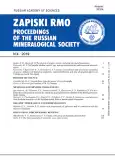Forms of occurrence and micro-nano ensambles of gold as indicators of formation conditions, spatial distribution, and type of orogenic deposits in Uzbekistan (South Tien Shan)
- Authors: Koneev R.I.1, Khalmatov R.A.2, Krivosheeva A.N.1
-
Affiliations:
- National University of Uzbekistan
- Center for Advaced Technologies
- Issue: Vol 148, No 4 (2019)
- Pages: 30-45
- Section: General section
- URL: https://journals.eco-vector.com/0869-6055/article/view/11361
- DOI: https://doi.org/10.30695/zrmo/2019.1484.02
- ID: 11361
Cite item
Abstract
Gold ore deposits of Uzbekistan are confined to the South Tien Shan orogenic belt. They are located in black shales (Muruntau, Amantaytau, Daugyztau), terrigenous sedimentary (Kokpatas), volcanic (Balpantau), and intrusive (Zarmitan, Guzhumsai) rocks. Their age is 280—290 Ma and coincides with the age of post-collision granitoid magmatism. The deposits form Kyzylkum and Nurata mining districts. Gold forms micro-nanoparticles and is incorporated into diversified compounds with Bi, Sb, As, Te, Se, S, Ag, Hg in primary quartz-sulfide and sulfide ores. Seven mineral and geochemical types of ores are recognized: Au—W with scheelite and molybdenite; Au—Bi—Te with maldonite, tellurides, bismuth sulpho-tellurides; Au—As with pyrite, arsenopyrite, Ni—Co minerals; Au—Ag—Te with calaverite, petzite, hessite, etc.; Au—Ag—Se with fichesserite, acanthite, freibergite, agvilarite, petrovskite, etc.; Au—Sb—Ag with aurostibite, boulangerite, burnonite, cincenite, chalcostibite, tetrahedrite, etc.; Au—Hg with cinnabar, consbergite, Hg-bearing native gold. Recoverable resources are determined by 2—3 types of ores. Three main types of gold deposits are proposed on the base of outlined mineralogical and geochemical types: Au—W—Bi—Te (Muruntau, Myutenbay, Zarmitan); Au—As—Sb—Ag (Amantaytau, Kokpatas, Daugyztau); Au—Ag—Sb—Se (Kosmanachi, Okzhetpes). The emphasis on the nanomineral approach in the study of gold, its compounds, and micro-nano ensembles increases the efficiency of searching, typifying and evaluating the prospects of hidden mineralization, and is favorable to determine the conditions of formation and technological properties of gold ores.
Keywords
Full Text
About the authors
Rustam I. Koneev
National University of Uzbekistan
Author for correspondence.
Email: ri.koneev@gmail.com
Doctor of Geological and Mineralogical Sciences, Professor of the Department Mineralogy and Geochemistry
Uzbekistan, Tashkent, Talabalar shaharchsi 1Rustam A. Khalmatov
Center for Advaced Technologies
Email: r.khalmatov@yahoo.com
Candidate of Geological and Mineralogical Sciences, Deputy Director for Science
Uzbekistan, Tashkent, Talabalar shaharchsi 3аAnna N. Krivosheeva
National University of Uzbekistan
Email: 91k.anna@gmail.com
Master, PhD student, Department of Mineralogy and Geochemistry
Uzbekistan, Tashkent c., Talabalar shaharchsi 1References
- Barton P. B. Jr., Skinner B. J. Sulfide mineral stabilities. In: Geochemistry of Hydrothermal Ore Deposits. Ed. by H. L. Barnes. New York: Wiley Interscience, 1979. P. 278-403.
- Baker T., Pollar P. J., Mustard R., Mark G., Graham J. A comparison of granite-related tin, tungsten, and gold-bismuth deposits: implications for exploration. Soc. Econ. Geol. Newsletter. N 61. 2005. P. 5-17.
- Goldfarb R. J., Taylor R. D., Collins G. S., Goryachev N. A., Orlandini O. F. Phanerozoic continental growth and gold metallogeny of Asia. Gondwana Research. 2014. Vol. 25. P. 48-102.
- Dolgopolava A., Seltmann R., Konopelka D., Koneev R., Divaev F. Geodynamic evolution of the western Tien Shan, Uzbekistan: Insights from U-Pb SHRIMP geochronology and Sr-Nd-Pb-Hf isotope mapping of granitoids. Gondwana Research. 2016. Vol. 47. P. 76-109.
- Koneev R. I. Nanomineralogy of gold in epithermal ore deposits of the Chatkalo-Kuramin region. Saint Petersburg: Delta, 2006. 218 p. (in Russian).
- Koneev R. I, Khalmatov R. A, Mun Y. S. Nanomineralogy and nanochemistry of ores from gold deposits of Uzbekistan. Geol. Ore Deposits. 2010. Vol. 52. N 8. P. 755-766.
- Kremenezkii A. A., Minzer A. F. Universality of gold systems as a key to the regional prospect of industrials ores. Native geology. 1995. N 1. P. 19-27 (in Russian).
- Nano-mineralogy. Ultra and nanodispersed state of mineral substances. Ed. by N. P. Yushkin, A. M. Aschabov, V. I. Rakin. Saint Petersburg: Nauka, 2005. 581 p. (in Russian).
- Nekrasov I. Ya. Geochemistry, mineralogy and genesis of gold deposits. Moscow: Nauka, 1991. 302 p. (in Russian).
- Roco M., Williams R., Alivisatos P. Nanotechnology research directions. IWGN Workshop Report. Boston: Kluwer academic publishers, 2001. 292 p.
- Rundqvist D. V. Time factor in the formation of hydrothermal deposit: Periods, epochs, megastages, and stages of ore formation. Geol. Ore Deposits. 1997. N 1. P. 8-19 (in Russian).
- Zelenov V. I. Methodology for the investigation of gold- and silver-bearing ores. Moscow: Nedra, 1989. 302 p. (in Russian).
Supplementary files










